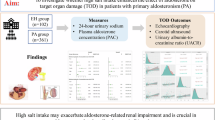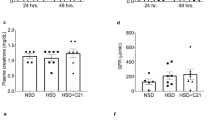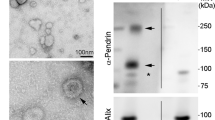Abstract
Recent studies have suggested that aldosterone plays a role in the pathogenesis of renal injury. In this study, we investigated whether local angiotensin II (Ang II) activity contributes to the progression of renal injury in aldosterone/salt-induced hypertensive rats. Uninephrectomized rats were treated with 1% NaCl in a drinking solution and one of the following combinations for 6 weeks: vehicle (2% ethanol, s.c.; n=9), aldosterone (0.75 μg/h, s.c.; n=8), aldosterone+Ang II type 1 receptor blocker olmesartan (10 mg/kg/day, p.o.; n=8), or aldosterone+olmesartan (100 mg/kg/day, p.o.; n=9). Aldosterone/salt-treated hypertensive rats exhibited severe proteinuria and renal injury characterized by glomerular sclerosis and tubulointerstitial fibrosis. Aldosterone/salt-induced renal injury was associated with augmented expression of angiotensin converting enzyme and Ang II levels in the renal cortex and medullary tissues. Renal cortical and medullary mRNA expression of transforming growth factor-β (TGF-β) and connective tissue growth factor (CTGF) as well as the collagen contents were increased in aldosterone/salt-treated hypertensive rats. Treatment with olmesartan (10 or 100 mg/kg/day) had no effect on blood pressure but attenuated proteinuria in a dose-dependent manner. Olmesartan at 10 mg/kg/day tended to decrease renal cortical and medullary Ang II levels, TGF-β and CTGF expression, and collagen contents; however, these changes were not significant. On the other hand, an ultrahigh dose of olmesartan (100 mg/kg/day) significantly decreased these values and ameliorated renal injury. These data suggest that augmented local Ang II activity contributes, at least partially, to the progression of aldosterone/salt-dependent renal injury.
Similar content being viewed by others
Article PDF
References
Takeda Y : Pleiotropic actions of aldosterone and the effects of eplerenone, a selective mineralocorticoid receptor antagonist. Hypertens Res 2004; 27: 781–789.
Hollenberg NK : Aldosterone in the development and progression of renal injury. Kidney Int 2004; 66: 1–9.
Sato A, Saruta T : Aldosterone-induced organ damage: plasma aldosterone level and inappropriate salt status. Hypertens Res 2004; 27: 303–310.
Nishiyama A, Yao L, Nagai Y, et al: Possible contributions of reactive oxygen species and mitogen-activated protein kinase to renal injury in aldosterone/salt-induced hypertensive rats. Hypertension 2004; 43: 841–848.
Blasi ER, Rocha R, Rudolph AE, Blomme EA, Polly ML, McMahon EG : Aldosterone/salt induces renal inflammation and fibrosis in hypertensive rats. Kidney Int 2003; 63: 1791–1800.
Rocha R, Chander PN, Khanna K, Zuckerman A, Stier CT Jr : Mineralocorticoid blockade reduces vascular injury in stroke-prone hypertensive rats. Hypertension 1998; 31: 451–458.
Feria I, Pichardo I, Juarez P, et al: Therapeutic benefit of spironolactone in experimental chronic cyclosporine A nephrotoxicity. Kidney Int 2003; 63: 43–52.
Brown NJ, Nakamura S, Ma L, et al: Aldosterone modulates plasminogen activator inhibitor-1 and glomerulosclerosis in vivo. Kidney Int 2000; 58: 1219–1227.
Chrysostomou A, Becker G : Spironolactone in addition to ACE inhibition to reduce proteinuria in patients with chronic renal disease. N Engl J Med 2001; 345: 925–926.
Sato A, Hayashi K, Naruse M, Saruta T : Effectiveness of aldosterone blockade in patients with diabetic nephropathy. Hypertension 2003; 41: 64–68.
Asai M, Monkawa T, Marumo T, et al: Spironolactone in combination with cilazapril ameliorates proteinuria and renal interstitial fibrosis in rats with anti–Thy-1 irreversible nephritis. Hypertens Res 2004; 27: 971–978.
Rachmani R, Slavachevsky I, Amit M, et al: The effect of spironolactone, cilazapril and their combination on albuminuria in patients with hypertension and diabetic nephropathy is independent of blood pressure reduction: a randomized controlled study. Diabet Med 2004; 21: 471–475.
Williams GH, Burgess E, Kolloch RE, et al: Efficacy of eplerenone versus enalapril as monotherapy in systemic hypertension. Am J Cardiol 2004; 93: 990–996.
Rocha R, Stier CT Jr, Kifor I, et al: Aldosterone: a mediator of myocardial necrosis and renal arteriopathy. Endocrinology 2000; 141: 3871–3878.
Fiebeler A, Nussberger J, Shagdarsuren E, et al: Aldosterone synthase inhibitor ameliorates angiotensin II–induced organ damage. Circulation 2005; 111: 3087–3094.
Hao L, Kanno Y, Fukushima R, Watanabe Y, Ishida Y, Suzuki H : Effects of eplerenone on heart and kidney in two-kidney, one-clip rats. Am J Nephrol 2004; 24: 54–60.
Greene EL, Kren S, Hostetter TH : Role of aldosterone in the remnant kidney model in the rat. J Clin Invest 1996; 98: 1063–1068.
Rocha R, Chander PN, Zuckerman A, Stier CT Jr : Role of aldosterone in renal vascular injury in stroke-prone hypertensive rats. Hypertension 1999; 33: 232–237.
Sun Y, Ramires FJ, Weber KT : Fibrosis of atria and great vessels in response to angiotensin II or aldosterone infusion. Cardiovasc Res 1997; 35: 138–147.
Robert V, Heymes C, Silvestre JS, Sabri A, Swynghedauw B, Delcayre C : Angiotensin AT1 receptor subtype as a cardiac target of aldosterone: role in aldosterone-salt–induced fibrosis. Hypertension 1999; 33: 981–986.
Sugiyama T, Yoshimoto T, Tsuchiya K, et al: Aldosterone induces angiotensin converting enzyme gene expression via a JAK2-dependent pathway in rat endothelial cells. Endocrinology 2005; 146: 3900–3906.
Harada E, Yoshimura M, Yasue H, et al: Aldosterone induces angiotensin-converting–enzyme gene expression in cultured neonatal rat cardiocytes. Circulation 2001; 104: 137–139.
Xiao F, Puddefoot JR, Barker S, Vinson GP : Mechanism for aldosterone potentiation of angiotensin II–stimulated rat arterial smooth muscle cell proliferation. Hypertension 2004; 44: 340–345.
Keidar S, Gamliel-Lazarovich A, Kaplan M, et al: Mineralocorticoid receptor blocker increases angiotensin-converting enzyme 2 activity in congestive heart failure patients. Circ Res 2005; 97: 946–953.
Sun Y, Zhang J, Zhang JQ, Ramires FJ : Local angiotensin II and transforming growth factor-beta1 in renal fibrosis of rats. Hypertension 2000; 35: 1078–1084.
Klar J, Vitzthum H, Kurtz A : Aldosterone enhances renin gene expression in juxtaglomerular cells. Am J Physiol Renal Physiol 2004; 286: F349–F355.
Rossing K, Schjoedt KJ, Jensen BR, Boomsma F, Parving HH : Enhanced renoprotective effects of ultrahigh doses of irbesartan in patients with type 2 diabetes and microalbuminuria. Kidney Int 2005; 68: 1190–1198.
Miyata T, van Ypersele de Strihou C, Ueda Y, et al: Angiotensin II receptor antagonists and angiotensin-converting enzyme inhibitors lower in vitro the formation of advanced glycation end products: biochemical mechanisms. J Am Soc Nephrol 2002; 13: 2478–2487.
Fujihara CK, Velho M, Malheiros DM, Zatz R : An extremely high dose of losartan affords superior renoprotection in the remnant model. Kidney Int 2005; 67: 1913–1924.
Schmieder RE, Klingbeil AU, Fleischmann EH, Veelken R, Delles C : Additional antiproteinuric effect of ultrahigh dose candesartan: a double-blind, randomized, prospective study. J Am Soc Nephrol 2005; 16: 3038–3045.
Koike H, Konse T, Sada T, et al: Olmesartan medoxomil, a novel potent angiotensin II blocker. Annu Rep Sankyo Res Lab 2003; 55: 1–91.
Jia N, Okamoto H, Shimizu T, et al: A newly developed angiotensin II type 1 receptor antagonist, CS866, promotes regression of cardiac hypertrophy by reducing integrin beta1 expression. Hypertens Res 2003; 26: 737–742.
Nagai Y, Yao L, Kobori H, et al: Temporary angiotensin II blockade at the prediabetic stage attenuates the development of renal injury in type 2 diabetic rats. J Am Soc Nephrol 2005; 16: 703–711.
Yao L, Kobori H, Rahman M, et al: Olmesartan improves endothelin-induced hypertension and oxidative stress in rats. Hypertens Res 2004; 27: 493–500.
Nishiyama A, Yoshizumi M, Rahman M, et al: Effects of AT1 receptor blockade on renal injury and mitogen-activated protein activity in Dahl salt-sensitive rats. Kidney Int 2004; 65: 972–981.
Fujii T, Takaoka M, Tsuruoka N, Kiso Y, Tanaka T, Matsumura Y : Dietary supplementation of L-carnosine prevents ischemia/reperfusion-induced renal injury in rats. Biol Pharm Bull 2005; 28: 361–363.
Sorooshian M, Olson JL, Meyer TW : Effect of angiotensin II blockade on renal injury in mineralocorticoid-salt hypertension. Hypertension 2000; 36: 569–574.
Iglarz M, Touyz RM, Viel EC, Amiri F, Schiffrin EL : Involvement of oxidative stress in the profibrotic action of aldosterone. Interaction wtih the renin-angiotension system. Am J Hypertens 2004; 17: 597–603.
Takeda Y : Genetic alterations in patients with primary aldosteronism. Hypertens Res 2001; 24: 469–474.
Takakuwa H, Shimizu K, Izumiya Y, et al: Dietary sodium restriction restores nocturnal reduction of blood pressure in patients with primary aldosteronism. Hypertens Res 2002; 25: 737–742.
Saito K, Ishizaka N, Aizawa T, et al: Role of aberrant iron homeostasis in the upregulation of transforming growth factor-β1 in the kidney of angiotensin II–induced hypertensive rats. Hypertens Res 2004; 27: 599–607.
Groholm T, Finckenberg P, Palojoki E, et al: Cardioprotective effects of vasopeptidase inhibition vs. angiotensin type 1−receptor blockade in spontaneously hypertensive rats on a high salt diet. Hypertens Res 2004; 27: 609–618.
Kobori H, Ozawa Y, Suzaki Y, Nishiyama A : Enhanced intrarenal angiotensinogen contributes to early renal injury in spontaneously hypertensive rats. J Am Soc Nephrol 2005; 16: 2073–2080.
Navar LG, Nishiyama A : Why are angiotensin concentrations so high in the kidney? Curr Opin Nephrol Hypertens 2004; 13: 107–115.
Morrissey JJ, Klahr S : Effect of AT2 receptor blockade on the pathogenesis of renal fibrosis. Am J Physiol 1999; 276: F39–F45.
Goto M, Mukoyama M, Sugawara A, et al: Expression and role of angiotensin II type 2 receptor in the kidney and mesangial cells of spontaneously hypertensive rats. Hypertens Res 2002; 25: 125–133.
Author information
Authors and Affiliations
Corresponding author
Rights and permissions
About this article
Cite this article
Fan, YY., Baba, R., Nagai, Y. et al. Augmentation of Intrarenal Angiotensin II Levels in Uninephrectomized Aldosterone/Salt-Treated Hypertensive Rats; Renoprotective Effects of an Ultrahigh Dose of Olmesartan. Hypertens Res 29, 169–178 (2006). https://doi.org/10.1291/hypres.29.169
Received:
Accepted:
Issue date:
DOI: https://doi.org/10.1291/hypres.29.169



